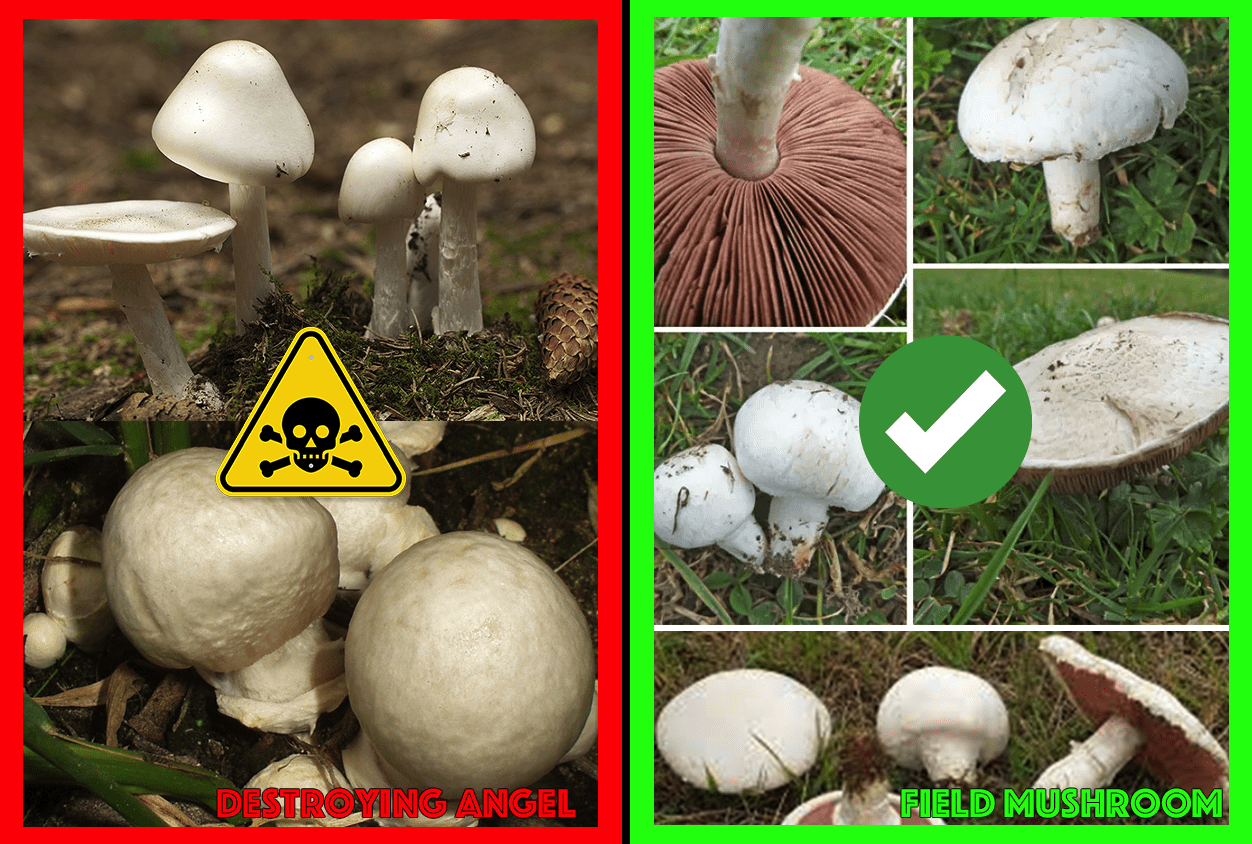There are a lot of poisonous mushrooms that look like edible mushrooms. Statistically1, the top 5 mushrooms that often confuse mushroom hunters are:
Death cap (Amanita phalloides) - This is one of the most poisonous mushrooms in the world and is responsible for most mushroom-related deaths. It is found in many parts of the world and has been misidentified as the edible straw mushroom (Volvariella volvacea), field mushroom (Agaricus campestris) and when young a puffball.
Destroying angel (Amanita verna) - This mushroom is another highly poisonous species found in many parts of the world. Destroying angel mushrooms have a few look-a-likes, the main one that looks similar is the edible meadow mushroom (Agaricus campestris).
False chanterelle (Hygrophoropsis aurantiaca) - This mushroom is found in North America and Europe and resembles the edible chanterelle (Cantharellus cibarius).
Jack-o'-lantern (Omphalotus olearius) - This mushroom is found in North America and resembles the edible orange chanterelle (Cantharellus californicus).
Fool's mushroom (Amanita citrina) - This mushroom is found in Europe and resembles the edible honey fungus (Armillaria mellea).
It is important to note that these are just a few examples and that there are many other poisonous mushrooms that can resemble edible species. If you are not an experienced mushroom hunter and are not able to accurately identify a mushroom, it is best to avoid consuming it or join one of our accredited courses. Below is a short excerpt from our Advanced Mushroom Identification Course.
1. Death Cap look-alikes

Death cap mushrooms can look like Asian paddy straw mushrooms, a cultivated edible species which does not grow naturally in the US. In 2016 a child died after eating a death cap that was mistaken for a paddy straw mushroom.
Paddy Straw Mushroom vs Death Cap

Death caps can also look like young puffball mushrooms when they are immature and in the small button stage. In 2003 an adult nearly died after mistaking a death cap for one of these. These mushrooms are particularly risky to recent immigrants who have a cultural tradition of foraging food from their environment. Apart from physical differences between these mushrooms, a key strategy for avoiding issues can be to understand the seasonality of Death Caps as summarized below.

For more information read this useful leaflet.
2. Destroying Angel look-alikes.

These deadly all-white mushrooms are in the genus Amanita. They can get confused with other white mushrooms, like the field mushroom. If you want to stay safe, avoid eating all white mushrooms. Read more...
3. Real vs False Chanterelles
Real chanterelles are edible mushrooms with a distinctive funnel shape and a vibrant orange or yellow color, while false chanterelles resemble true chanterelles but often have a more irregular shape, a paler color, and may have a slightly different texture; they can be toxic if consumed.
4. Jack-o'-lantern look-a-likes

Jack-o'-lanterns exhibit a bright orange color and typically grow in clusters on decaying wood, often emitting a faint greenish glow in low light due to bioluminescence. Their cap is flatter with sharp, closely packed gills underneath. In contrast, true chanterelles display a golden to yellow hue and usually grow individually or in small groups on the forest floor near trees. They have a distinct funnel-shaped cap with ridges or folds down the stem. Additionally, chanterelles release a fruity, apricot-like aroma and produce a creamy or white spore print, which can aid in accurate identification.
5. The Fool's Mushroom

It's called The Fool's Mushroom for a reason! It has been known to be miss identified as Honey Fungus, however, there are vast differences between the two. For a start, The Fool's mushroom is an Amanita species (again it's usually ALL white) and grows by itself. Whereas Honey Fungus typically grows in clusters of honey-colored to dark-brown mushrooms.
Other common look-a-likes
6. False Morels and Real Morels.

Morels which have irregular and wrinkled caps can be poisonous. Click the link to learn more about identifying the differences between morels and false morels.
7. Magic Mushrooms and Galerina.

The most common magic mushroom lookalikes are the Galerina species. A general rule to avoid this is that psilocybe fruiting bodies stain blue to varying degrees when bruised, while Galerina mushrooms do not. We offer a Magic Mushroom identification course where you can learn a bit more on this topic.
Did you enjoy this article and want to know more?
All of our resources are proofread by a licensed pharmacist so you know they can be trusted. In our premium courses, we teach a technique used in medicine called differential diagnosis which offers a foolproof way to not get confused with the list above. The idea is lots of different mushrooms can look the same, in fact in mycology there is a term for indiscriminate mushrooms called LBMs (little brown mushrooms). LBMs are mushrooms that even season mycologists cannot recognise as they are so generic. Differential diagnosis looks firstly at the most commonly mistaken mushrooms (see list above) and then isolates their look alike and gives students resources that highlight the differentiating characteristics. The first mushroom we will look at are mushrooms that look like the notorious Death Cap.
If you would like to access the full list of poisonous mushroom look-alikes please subscribe to one of our courses found on the front page of this site.
References
1Wennig R, Eyer F, Schaper A, Zilker T, Andresen-Streichert H. Mushroom Poisoning. Dtsch Arztebl Int. 2020 Oct 16;117(42):701-708. doi: 10.3238/arztebl.2020.0701. PMID: 33559585; PMCID: PMC7868946. Accessed via: https://pubmed.ncbi.nlm.nih.gov/33559585/

